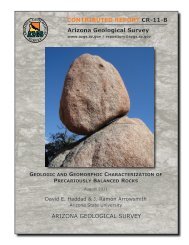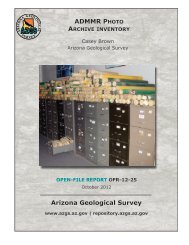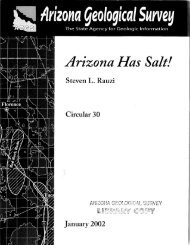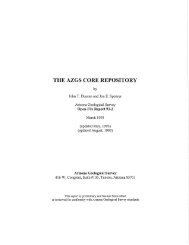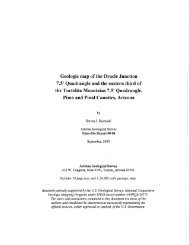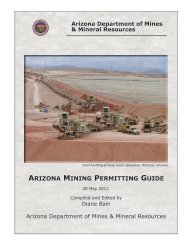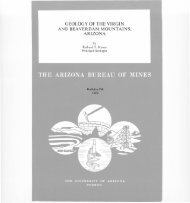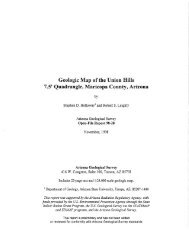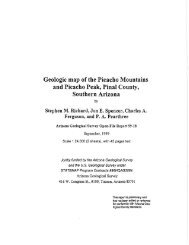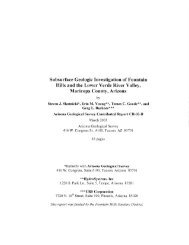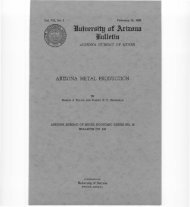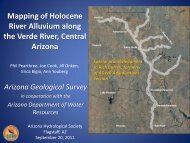Structural-Geologic Map Relationships in the Salcito Ranch Area,
Structural-Geologic Map Relationships in the Salcito Ranch Area,
Structural-Geologic Map Relationships in the Salcito Ranch Area,
You also want an ePaper? Increase the reach of your titles
YUMPU automatically turns print PDFs into web optimized ePapers that Google loves.
Directly above <strong>the</strong> Catal<strong>in</strong>a detachment fault <strong>in</strong> <strong>the</strong> sou<strong>the</strong>astern part of <strong>the</strong> area<br />
are Precambrian rocks, <strong>in</strong>clud<strong>in</strong>g P<strong>in</strong>al Schist and Johnny Lyon Granodiorite, both<br />
Proterozoic <strong>in</strong> age (see Plate 1). Tectonic slices conta<strong>in</strong><strong>in</strong>g each of <strong>the</strong>se formations<br />
are no greater than 15 m thick. Above <strong>the</strong> tectonic slices of Precambrian rocks are<br />
slices of Paleozoic formations, all <strong>in</strong> <strong>the</strong> correct stratigraphic order but each dim<strong>in</strong>ished<br />
<strong>in</strong> thickness compared to measured thicknesses <strong>in</strong> nearby ranges outside of <strong>the</strong><br />
Catal<strong>in</strong>a-R<strong>in</strong>con metamorphic core complex (see Figure 3). The sequence of<br />
Paleozoic formations, from older to younger, <strong>in</strong>cludes Bolsa Quartzite (middle<br />
Cambrian), Abrigo Formation (upper and middle Cambrian), Mart<strong>in</strong> Formation (Upper<br />
Devonian), Escabrosa Limestone (Mississippian), Horquilla Limestone (upper and<br />
middle Pennsylvanian), and Earp Formation (Lower Permian and upper Pennsylvanian).<br />
The contrast between <strong>the</strong> normal section versus <strong>the</strong> tectonically th<strong>in</strong>ned section reveals<br />
a reduction <strong>in</strong> thickness to 10 to 50 percent of orig<strong>in</strong>al.<br />
Th<strong>in</strong>n<strong>in</strong>g of <strong>the</strong> upper plate has been accomplished by down-to-<strong>the</strong>-southwest<br />
shear<strong>in</strong>g and fault<strong>in</strong>g. As reported by Davis (1975, 1981, 1987) and Lim<strong>in</strong>g (1974), <strong>the</strong><br />
Horquilla Formation is replete with overturned fold structures which verge south to<br />
southwest and which can be <strong>in</strong>terpreted via separation arc methodology as a response<br />
to top to <strong>the</strong> southwest movement. Axial surfaces for <strong>the</strong>se folds are <strong>in</strong>cl<strong>in</strong>ed to <strong>the</strong><br />
north and nor<strong>the</strong>ast. Some faults which are <strong>in</strong> part responsible for th<strong>in</strong>n<strong>in</strong>g of <strong>the</strong> section<br />
are quite mappable with<strong>in</strong> <strong>the</strong> upper plate of <strong>the</strong> Catal<strong>in</strong>a detachment fault.<br />
Oligocene-Miocene sandstones and conglomerates of <strong>the</strong> Pantano Formation<br />
10



